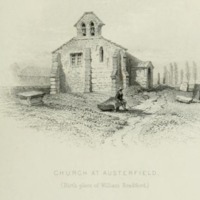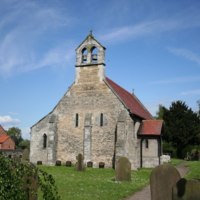Description
William Bradford was baptised in St Helena’s Church, Austerfield. Since William Henry Bartlett’s description and illustration of the building in the 1850s the church has reflected is association with the New Plymouth Governor. In 1897 the north aisle was built in his memory and a stained-glass window showing Bradford and the Mayflower was installed in 1992. Bartlett provides a romantic description of his journey to the church and conversation with the local residents:
"It was one of those fresh bright days when the silvery clouds are driven along the sky by a pleasant breeze, and when the rapidly fleeting shadows, cast by them, chase each other playfully along the waving surface of the corn-fields. The lark, high in the heavens, trilled out her joyous music, rising higher and higher, till the notes were but faintly audible in the sunny sky, and then rushing down nearer and nearer to the earth with fresh bursts of her inexhaustible melody. On gaining a rising ground, the birth-place of William Bradford appeared below — a hamlet of the most humble description, simply a double row of rustic cottages, old-fashioned and mossy, but with their geraniums in the windows, and bright patches of flowers in the little gardens, displaying that neatness and instinctive rural taste peculiar to the better class of English husbandmen. In one of these peasant nests abode the old sexton, whom I forth- with sought out. He was a venerable man, bending beneath the weight of seventy years; yet still hale and hearty, his cheek, like that of " Adam "in "As You Like it," resembled "a Avinter apple, frosty but kindly," and his antiquated garments, patched and darned as they were by the labour of his aged help-mate, had an air of neatness and propriety. Under his guidance I proceeded to the church, (see title-page,) which, like the village, is of the smallest possible dimensions, but of most venerable antiquity, its foundation dating probably from the eleventh to the twelfth century.
The grass of the church-yard is almost deep and rich as moss, with a few grave-stones scattered over, among which I sought in vain for any belonging to the Bradfords, the majority of whom no doubt still continued to attend that church, his secession from which drew down upon the youthful Bradford so much obloquy and persecution. Within a modern porch thrown out for convenience, is a very curious old door of early Norman date, as its heavy massive capitals, its irregular zigzag moulding of all sizes and shapes, its fish-head ornament, and, what was doubtless intended as the chef d'oeuvre of the sculptor's skill, a basso relievo of the old enemy of mankind, under the guise of a serpent with expanded mouth and grinning fangs, do all evidently testify."
"It was one of those fresh bright days when the silvery clouds are driven along the sky by a pleasant breeze, and when the rapidly fleeting shadows, cast by them, chase each other playfully along the waving surface of the corn-fields. The lark, high in the heavens, trilled out her joyous music, rising higher and higher, till the notes were but faintly audible in the sunny sky, and then rushing down nearer and nearer to the earth with fresh bursts of her inexhaustible melody. On gaining a rising ground, the birth-place of William Bradford appeared below — a hamlet of the most humble description, simply a double row of rustic cottages, old-fashioned and mossy, but with their geraniums in the windows, and bright patches of flowers in the little gardens, displaying that neatness and instinctive rural taste peculiar to the better class of English husbandmen. In one of these peasant nests abode the old sexton, whom I forth- with sought out. He was a venerable man, bending beneath the weight of seventy years; yet still hale and hearty, his cheek, like that of " Adam "in "As You Like it," resembled "a Avinter apple, frosty but kindly," and his antiquated garments, patched and darned as they were by the labour of his aged help-mate, had an air of neatness and propriety. Under his guidance I proceeded to the church, (see title-page,) which, like the village, is of the smallest possible dimensions, but of most venerable antiquity, its foundation dating probably from the eleventh to the twelfth century.
The grass of the church-yard is almost deep and rich as moss, with a few grave-stones scattered over, among which I sought in vain for any belonging to the Bradfords, the majority of whom no doubt still continued to attend that church, his secession from which drew down upon the youthful Bradford so much obloquy and persecution. Within a modern porch thrown out for convenience, is a very curious old door of early Norman date, as its heavy massive capitals, its irregular zigzag moulding of all sizes and shapes, its fish-head ornament, and, what was doubtless intended as the chef d'oeuvre of the sculptor's skill, a basso relievo of the old enemy of mankind, under the guise of a serpent with expanded mouth and grinning fangs, do all evidently testify."
Source
William Henry Bartlett, The Pilgrim Fathers, or, The Founders of New England in the Reign of James the First (London: Arthur Hall, Virtue & co, 1854), p.36.



